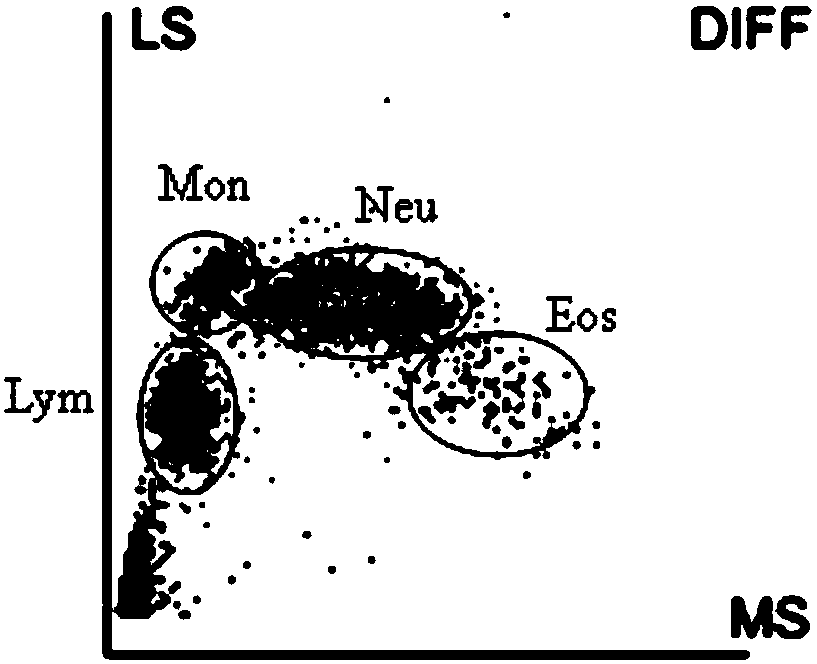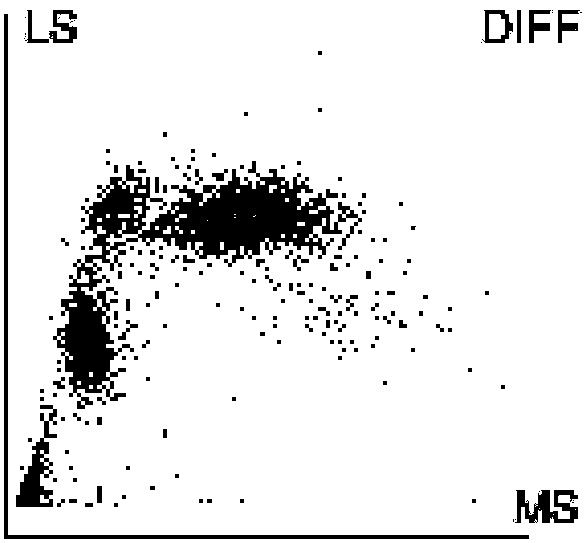White blood cell classification reagent
A white blood cell classification and reagent technology, which is applied in the field of blood cell analysis, can solve the problems of not clear graphic classification, narrow applicable temperature range, etc., and achieves the effect of obvious location demarcation, wide temperature range and convenient use.
- Summary
- Abstract
- Description
- Claims
- Application Information
AI Technical Summary
Problems solved by technology
Method used
Image
Examples
Embodiment 1
[0046] A reagent for the five classifications of white blood cells, which consists of the following components:
[0047]
[0048] The pH of the reagent prepared according to the above formula is 4.5. The above reagents were tested on the blood sample A on the DF50 automatic blood cell analyzer, and the results were as follows: figure 1 As shown, the white blood cells can be divided into four clear cell groups of lymphocytes, monocytes, neutrophils and eosinophils on the scatter diagram.
Embodiment 2
[0050] A reagent for the five classifications of white blood cells, which consists of the following components:
[0051]
[0052]
[0053] The pH of the reagent prepared according to the above formula is 5.5. The above reagents were tested on blood sample B on the DF50 automatic blood cell analyzer, and the results were as follows: figure 2 As shown, the white blood cells can be divided into four clear cell groups of lymphocytes, monocytes, neutrophils and eosinophils on the scatter diagram.
Embodiment 3
[0055] A reagent for the five classifications of white blood cells, which consists of the following components:
[0056]
[0057] The pH of the reagent prepared according to the above formula is 4.2. The above reagents were tested on blood sample C on the DF50 automatic blood cell analyzer, and the results were as follows: image 3 As shown, the white blood cells can be divided into four clear cell groups of lymphocytes, monocytes, neutrophils and eosinophils on the scatter diagram.
PUM
 Login to View More
Login to View More Abstract
Description
Claims
Application Information
 Login to View More
Login to View More - R&D
- Intellectual Property
- Life Sciences
- Materials
- Tech Scout
- Unparalleled Data Quality
- Higher Quality Content
- 60% Fewer Hallucinations
Browse by: Latest US Patents, China's latest patents, Technical Efficacy Thesaurus, Application Domain, Technology Topic, Popular Technical Reports.
© 2025 PatSnap. All rights reserved.Legal|Privacy policy|Modern Slavery Act Transparency Statement|Sitemap|About US| Contact US: help@patsnap.com



